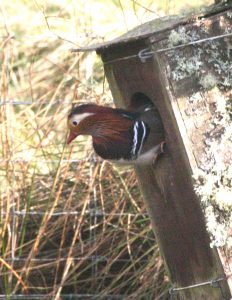 Nest boxes for birds vary from the small design aimed at birds varying from great tits to redstarts to the much larger ones known as a chimney box. The latter is designed mainly for tawny owls although other bird will take advantage of such a ready made hole. Nest boxes of any size are aimed at replacing natural holes in trees that have become much rarer as older tree are felled or fall down. In many woodlands or tall, thick hedges the food and shelter may be there for birds but if nest holes are not available then the birds have to look elsewhere when the breeding season comes around. The standard nest box for tawny owls is very basic as there are four planks of wood, twenty inches long and ten inches wide and two small pieces for the top and bottom. The entrance hole to be about 150 mm diameter.
Nest boxes for birds vary from the small design aimed at birds varying from great tits to redstarts to the much larger ones known as a chimney box. The latter is designed mainly for tawny owls although other bird will take advantage of such a ready made hole. Nest boxes of any size are aimed at replacing natural holes in trees that have become much rarer as older tree are felled or fall down. In many woodlands or tall, thick hedges the food and shelter may be there for birds but if nest holes are not available then the birds have to look elsewhere when the breeding season comes around. The standard nest box for tawny owls is very basic as there are four planks of wood, twenty inches long and ten inches wide and two small pieces for the top and bottom. The entrance hole to be about 150 mm diameter.
One interesting aspect about tawny owls is their pattern of behaviour, especially at this time of the year. They are now calling to pair up and to set up territory despite the fact that the eggs will not be laid until late February or March. The call that can now be heard, some people call it a hoot, is a male that will go “hooo-hoo-hooo”. This claims his territory and is used extensively during courtship. It tells other males to clear off and entices females into his area and the nest site. Another commonly heard call is “kee-wick” which is a contact call made by both male and female. The female alone incubates the two to three eggs and, unlike other birds, the incubation starts as soon as the first egg is laid. This means that the eggs do not hatch together and that the owlets vary in age and size. This means that if there is a shortage of food the older chicks survive whilst the others will die from starvation. Older chicks eating younger siblings is not unknown. Owlets will leave their nest around 37 days and will hang around on nearby branches for another few days. However, they are dependent on their parents for another three months.
During the day tawny owls roost in hollow trees but they will also seek other shelter such as in ivy or will just sit on a branch tight against the trunk of the tree where they are well camouflaged and difficult to see. They may hunt from a perch or hover. They are also renowned for defending their nest site and have been known to attack humans. The famous bird photographer, Eric Hosking, lost an eye to a tawny owl that he was photographing the nest from a hide. The commonest prey of this owl are small mammals, especially voles, mice and shrews. It also takes a range of birds such as starlings, finches, thrushes and sparrows. However, it also takes a range of other food from amphibians to earthworms and insects. They have been known to eat fish although it is not clear how it gets them although one suggestion is that it snatches them from the surface of the water.
If one of these nest boxes is not taken up by these owls then later it attracts ducks such as mandarins, the photograph shows a drake peering out, goldeneye and another owl, the barn owl. Starlings and jackdaws will also take over such boxes. The latest trend, and nobody knows the significance of this, is the pine marten that will rear their kits in such boxes
Tags: highland birds
